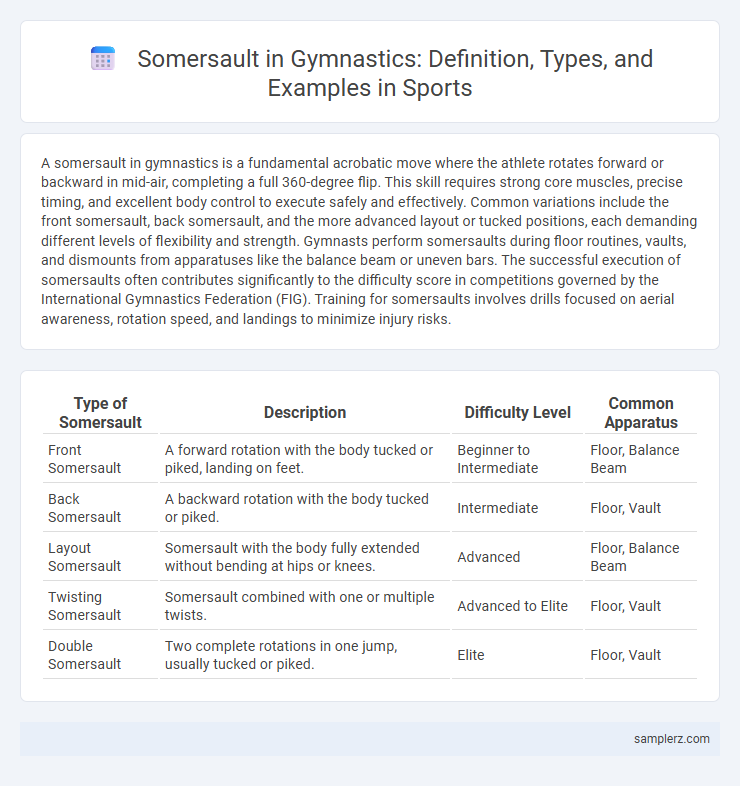A somersault in gymnastics is a fundamental acrobatic move where the athlete rotates forward or backward in mid-air, completing a full 360-degree flip. This skill requires strong core muscles, precise timing, and excellent body control to execute safely and effectively. Common variations include the front somersault, back somersault, and the more advanced layout or tucked positions, each demanding different levels of flexibility and strength. Gymnasts perform somersaults during floor routines, vaults, and dismounts from apparatuses like the balance beam or uneven bars. The successful execution of somersaults often contributes significantly to the difficulty score in competitions governed by the International Gymnastics Federation (FIG). Training for somersaults involves drills focused on aerial awareness, rotation speed, and landings to minimize injury risks.
Table of Comparison
| Type of Somersault | Description | Difficulty Level | Common Apparatus |
|---|---|---|---|
| Front Somersault | A forward rotation with the body tucked or piked, landing on feet. | Beginner to Intermediate | Floor, Balance Beam |
| Back Somersault | A backward rotation with the body tucked or piked. | Intermediate | Floor, Vault |
| Layout Somersault | Somersault with the body fully extended without bending at hips or knees. | Advanced | Floor, Balance Beam |
| Twisting Somersault | Somersault combined with one or multiple twists. | Advanced to Elite | Floor, Vault |
| Double Somersault | Two complete rotations in one jump, usually tucked or piked. | Elite | Floor, Vault |
Common Somersault Variations in Gymnastics
Common somersault variations in gymnastics include the front somersault, back somersault, and aerial somersault, each demonstrating different body rotations and aerial techniques. The tucked, piked, and layout positions modify body posture during the somersault, affecting rotation speed and difficulty level. These variations contribute to gymnasts' scoring by showcasing control, form, and execution precision in competitions.
Forward Somersault: Technique and Execution
A forward somersault in gymnastics requires a precise sequence of movements starting with a strong run-up and a powerful jump, propelling the gymnast into a tight tuck position to complete a full front rotation. Proper technique involves maintaining body alignment and controlling the tuck to maximize rotational speed while preparing for a balanced landing. Execution depends on core strength, spatial awareness, and timing to ensure the gymnast lands safely and with stability on their feet.
Backward Somersault Moves Explained
The backward somersault in gymnastics involves a powerful tuck or pike rotation where the athlete flips backward through the air, initiating the move by jumping off the ground with strong leg drive and a tight core. Key elements include a controlled takeoff, precise body alignment, and a focused spot on landing to ensure balance and safety. Mastering backward somersaults enhances aerial awareness, coordination, and overall gymnastic performance.
The Aerial Somersault in Floor Routines
The Aerial Somersault in floor routines is a high-difficulty gymnastics skill involving a fully airborne, unassisted flip without hand support. This element showcases exceptional body control, spatial awareness, and explosive power, often pivotal in scoring higher execution and difficulty ratings in competitions. Elite gymnasts integrate multiple aerial somersaults within a floor sequence to maximize routine complexity and artistic impression.
Handspring Somersault Combinations
Handspring somersault combinations in gymnastics showcase a dynamic sequence where athletes execute a powerful handspring into a forward or backward somersault, seamlessly linking multiple rotations. These combinations demand exceptional upper body strength, precise timing, and spatial awareness to maintain momentum and form throughout the routine. Mastery of handspring somersaults enhances overall performance scores by demonstrating advanced acrobatic skills and fluid transitions.
Somersaults on Balance Beam: Skills and Challenges
Somersaults on the balance beam demand exceptional balance, precision, and spatial awareness, as athletes perform forward or backward flips on a narrow 10-centimeter surface that is only 1.25 meters high. Key skills include the tuck, pike, and layout somersaults, each requiring optimal body control to maintain stability and avoid falls during rotations. The primary challenge lies in executing these complex airborne maneuvers with flawless form while maintaining a seamless flow in the routine to maximize difficulty scores in competitions.
Vaulting Somersaults: Popular Examples
Vaulting somersaults in gymnastics include the Yurchenko, known for its round-off onto the springboard followed by a back handspring onto the vault table and a flip in the air. The Tsukahara features a quarter turn onto the vault table with a backward somersault off, often executed with twists to increase difficulty. These vaulting techniques combine power, speed, and aerial awareness, making them iconic in competitive gymnastics vault events.
Uneven Bars: Somersault Elements and Transitions
Somersault elements on the uneven bars include the Tkatchev and Jaeger release moves, where gymnasts perform backward or forward somersaults transitioning between bars. These dynamic skills require precise timing and body control to maintain momentum while executing complex aerial rotations. Smooth transitions incorporating somersaults enhance routine difficulty and contribute to higher execution and difficulty scores in gymnastics competitions.
Olympic Gymnasts Famous for Somersault Skills
Olympic gymnasts like Simone Biles and Kohei Uchimura are renowned for their exceptional somersault skills, often executing complex aerial flips during floor routines and vault events. Simone Biles' signature double-double somersault demonstrates unparalleled power and precision, setting new standards in women's gymnastics. Kohei Uchimura's mastery of somersault techniques contributes to his six-time World All-Around Champion status, highlighting the importance of acrobatic flair in elite Olympic competition.
Safety Precautions When Performing Somersaults
Proper safety precautions when performing somersaults in gymnastics include using cushioned mats to reduce impact and wearing appropriate protective gear such as wrist guards and helmets. Gymnasts must ensure correct technique and body alignment to prevent neck and spine injuries during flips. Supervision by a qualified coach is essential to provide guidance and immediate assistance in case of falls or improper landings.

example of somersault in gymnastics Infographic
 samplerz.com
samplerz.com